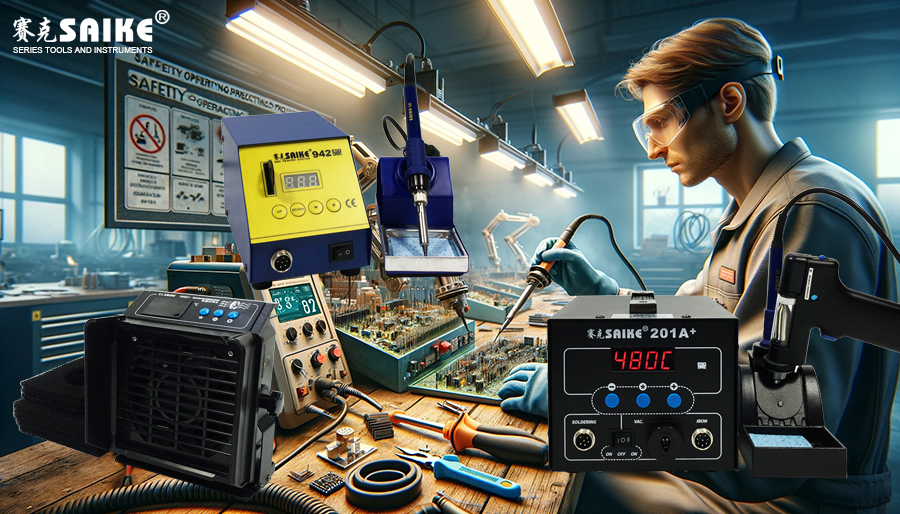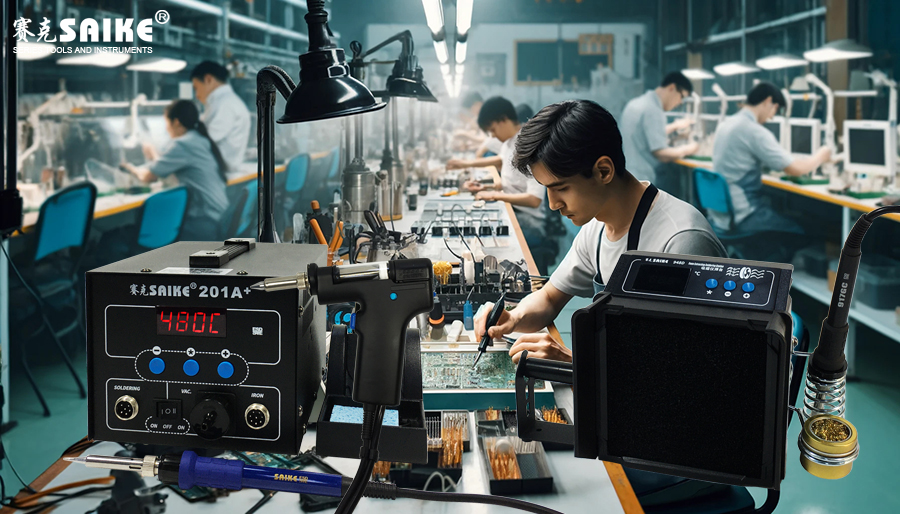
SK-YJ000HT-KP 100008
Soldering stations, commonly used in electronic manufacturing and repair, require safe operation practices to ensure the safety of personnel and enhance work efficiency. Improper handling can not only cause personal injury but also damage equipment or result in property loss. This article provides a detailed overview of safety operating procedures for soldering stations, aiming to assist operators in understanding and implementing necessary safety measures.
I. Preparation for Safe Operation of Soldering Stations
1.Confirming Equipment Status
– Check power cords and plugs: Ensure there is no wear, cracks, or other damage. Damaged power cords can cause electric shocks or fires.
– Inspect the soldering station and soldering iron: Make sure the soldering station surface is clean and clear of debris, and the soldering iron tip is not damaged or excessively worn.
2.Wearing Appropriate Personal Protective Equipment (PPE)
– Protective eyewear: Shields eyes from flying hot solder and harmful light rays.
– Heat-resistant gloves: Wear heat-resistant gloves, especially when handling high-temperature soldering irons.
– Long-sleeved work clothes: Wear flame-resistant material work clothes to protect the skin from burns.
3.Preparing a Suitable Work Environment
– Adequate ventilation: Ensure the work area has sufficient ventilation to reduce the risk of inhaling harmful fumes and gases.
– Clean workbench: Keep the workbench surface clean and tidy, away from flammable materials and sensitive equipment.
II. Safe Use of Soldering Stations
1.Proper Use of Soldering Station Equipment
– Follow operation guidelines: Operate the soldering station according to the manufacturer’s instructions, without exceeding the recommended temperature and operating conditions.
– Temperature control: Set the soldering iron temperature correctly. Excessively high temperatures can damage components or cause personal injury.
– Soldering iron placement: Always return the soldering iron to its stand during use, avoiding contact with flammable or conductive objects.
2.Preventing Electric Shock and Fire
– Prevent water splashes: Ensure no water splashes into the equipment in the work area, and avoid using wet hands during operation.
– Avoid overload: Do not share a power outlet between the soldering station and other high-power equipment to prevent circuit overloads.
3.Handling Soldering Fumes
– Use a fume extractor: Whenever possible, use a fume extractor or exhaust fan to minimize fume inhalation.
III. Safety Inspection and Maintenance After Using Soldering Stations
1.Shutdown and Power Off
– Turn off the equipment: Ensure the soldering station is turned off and unplugged after use, preventing accidental heating when not in use.
2.Cleaning and Inspection
– Clean the soldering iron tip: Use specialized tools to remove residual solder from the soldering iron tip.
– Regular maintenance: Periodically inspect all parts of the soldering station, and replace the soldering iron tip or other wearable parts if necessary.
3.Safe Storage
– Proper storage: Store the soldering station and its accessories in a dry, clean place inaccessible to children.
IV. Conclusion
By following the aforementioned safety operating procedures for soldering stations, operators can not only protect themselves from harm but also prevent equipment damage, thereby extending its lifespan. Raising safety awareness and developing proper operational habits are crucial to ensuring smooth soldering operations. Implementing these safety measures is fundamental to maintaining a safe workplace in any environment where soldering stations are used.


